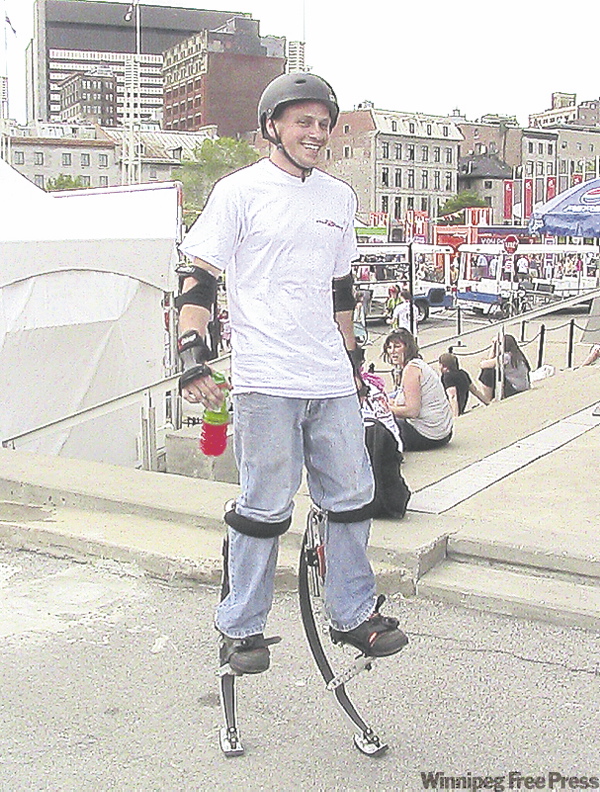Docs recoil at popular stilt craze
Worry about head injuries
Advertisement
Read this article for free:
or
Already have an account? Log in here »
To continue reading, please subscribe:
Monthly Digital Subscription
$1 per week for 24 weeks*
- Enjoy unlimited reading on winnipegfreepress.com
- Read the E-Edition, our digital replica newspaper
- Access News Break, our award-winning app
- Play interactive puzzles
*Billed as $4.00 plus GST every four weeks. After 24 weeks, price increases to the regular rate of $19.00 plus GST every four weeks. Offer available to new and qualified returning subscribers only. Cancel any time.
Monthly Digital Subscription
$4.75/week*
- Enjoy unlimited reading on winnipegfreepress.com
- Read the E-Edition, our digital replica newspaper
- Access News Break, our award-winning app
- Play interactive puzzles
*Billed as $19 plus GST every four weeks. Cancel any time.
To continue reading, please subscribe:
Add Winnipeg Free Press access to your Brandon Sun subscription for only
$1 for the first 4 weeks*
*$1 will be added to your next bill. After your 4 weeks access is complete your rate will increase by $0.00 a X percent off the regular rate.
Read unlimited articles for free today:
or
Already have an account? Log in here »
Hey there, time traveller!
This article was published 14/08/2009 (5891 days ago), so information in it may no longer be current.
MONTREAL — The recent commercialization in Canada of jumping stilts has raised concerns among doctors who are worried about head injuries suffered by people who practise “powerbocking.”
The shiny, metallic, curved springs are strapped on just below the knee and vendors say they allow users to jump higher, run faster and even perform acrobatic backflips.
Enthusiasts of the stilts are known as “powerbockers” in honour of Alexander Boeck, the German aerospace engineer credited with inventing them in 2003.

More recently, they were brought to world attention when 200 people performed on them at the closing ceremonies of the 2008 Olympics in Beijing.
The stilts, which are made of composite fibreglass, have caught on in Europe and Asia but there are no formal studies on the number or the type of injuries that result from powerbocking.
Dr. Scott Delaney, a sports medicine physician for the Montreal Alouettes, said he’s worried about head and upper body injuries.
“They are upwards of 18 inches off the ground, so when they fall they’re going to be falling straight on their head if they fall backwards,” he said.
Delaney said there is also the risk of elbow, shoulder and hand injuries, especially if a runner falls forward on the stilts and tries to put an arm out to break a fall.
Delaney would like to see the stilts sold as a package with a helmet, wrist guards and elbow and knee pads.
“I just really worry,” he added.
Marlyn Gagne, a Montreal distributor for the Power Strider brand, says the stilts are no more dangerous than in-line skates. “And I would say it’s safer because it’s easier to keep your balance than it is on skates.”
Gagne said she has sold at least 300 pairs in Quebec since May and has had no reports of any injuries, adding the stilts can also help people shed extra weight.
“I would say that once you get on them, you can burn up to 400 calories in 15 minutes (because) it’s very demanding physically.”
The stilts come in different sizes and can be used by children. “There are junior models that retail for $300,” Gagne said. The adult models of Power Striders generally retail from $400 to $600.
It’s one of two major brands of the Chinese-made jumping stilts currently on sale in Canada.
Peter Filippelli, who distributes the Fly Jumper brand online, says parents shouldn’t worry.
“Kids aren’t too likely to get hurt on them,” he said.
“They’re only small-scale versions of adult models, they’re only six inches off the ground and kids can hardly jump two feet high on them.”
Ian Shrier, a consulting medical director for the Cirque du Soleil, says anybody who is just starting to use the stilts must be careful. “If people are smart about it , they will hopefully catch on to the safety part and be prudent from the outset, instead of waiting until we get a rash of injuries.”
— The Canadian Press

